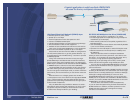
2 of 6
FEATURES
• Send async data across short-
and medium-range distances.
• Use existing in-house twisted-pair
wiring to transmit data.
• Choose from a variety of data rates—
as high as 115.2 kbps with the high-
speed SHM-B.
• Most offered as cards for rackmounting.
• Models for multipoint applications
available.
• Microdriver 9 can be ordered with
surge protection.
• Choose nonpowered models for
simple installation.
OVERVIEW
If you want to transmit data from your computing equip-
ment further than the 50-foot (15.2-m) RS-232 limit but don’t
need a modem (which can transmit data worldwide), then
order a Microdriver 9, Short-Haul Modem-B, or RS-232/RS-485
Multipoint Line Driver.
These compact, easy-to-install datacommunication devices
can exchange data within a building or across town. Higher
data rates yield shorter distances. For details and distance/speed
specifications for specific models, see the following pages.
What should you consider when choosing the model that’s
right for your application? First, determine whether you need
a nonpowered or powered device.
The nonpowered models plug into the connector at the
communications port of your DTE and derive their power
from the port’s interface (RS-232/ITU V.24) via one or more
of the connector’s pins. All Microdriver 9 models are powered
this way.
Before choosing a specific nonpowered device, you’ll need
to confirm that your computing equipment has the pins needed
to run the device. Then determine the gender of your compu-
ter’s comm port connector and select a model with the proper
connector gender.
Choose a powered device if your computer can’t support
nonpowered units and/or you prefer to rackmount equip-
ment. Our Short-Haul Modem-B, High-Speed Short-Haul
Modem-B, and RS-232/RS-485 Multipoint Line Drivers are all
powered, requiring standard AC current to operate. They’re
available in standalone and rackmount card models. When
choosing your model, consider your available installation
space, the total units needed, and your existing equipment.
Next, determine if your system or software support is
sending data in a point-to-point or multipoint installation.
Except for the RS-232/RS-485 Multipoint Line Driver, all models
featured here are designed to work point-to-point.
If you have a point-to-point network, you’ll need a device
that matches the type of wiring in your installation, whether
it’s in-house wiring for on-site applications or a 4-wire twisted-
pair Local Area Data Circuit (LADC) leased from your phone
company to send data off-site. In-house wiring will be either
2-or 4-wire twisted-pair cable that exists in your building or
that you will install.
Lastly, determine the speed you want your data to travel,
reviewing your computer’s limitations to see if it supports
high speeds, and the distance it must travel. You’ll also need
to consider how much room for error you can tolerate in data
exchanges, what wire gauge(s) will be used, and how many
splices will exist in the wire.
Microdriver 9
• Nonpowered, point-to-point, 4-wire or 5-screw
terminal block.
• Saves space—plugs into your PC’s DB9 serial port.
• Sends data up to 17 miles (27.4 km) at 1200 bps using
24 AWG gauge wire.
• Models are available with RJ-11, RJ-45, or 5-screw terminal
block connectors.
This compact short-range, asynchronous, point-to-point,
full-duplex line driver plugs directly into your computer or
terminal port, and all power is drawn from the RS-232
interface.
It‘s perfect for installations where there‘s no room to
spare. Surface-mount technology makes the Microdriver 9’s
small size possible.
Used in pairs, the Microdriver 9 enables two asynchronous
RS-232 devices with DB9 connectors to communicate at
distances up to 17 miles (27.4 km) at 1200 bps over 24 AWG
wiring.
Models available include:
• The Microdriver 9 RJ-11 (ME790A-M, ME790A-F,
ME792A-MSP, ME792A-FSP) has a female RJ-11 connector
to connect to the twisted-pair lines and a male or female
DB9 connector to connect to your computer port. Surge-
protected (SP) versions feature 600-watt power dissipa-
tion at 1 ms and a response time of 1.0 picoseconds.
• The Microdriver 9 RJ-45 (ME794A-M, ME1794A-F) has
a female RJ-45 to connect to the twisted-pair lines and
a male or female DB9 connector to connect to your
computer port.
• The Microdriver 9 5-Screw Terminal Block (ME1791A-F)
has a 5-screw terminal block to connect to the twisted-
pair lines and a female DB9 connector to connect to your
computer port.
5/2/2007
#11220
724-746-5500 blackbox.com








